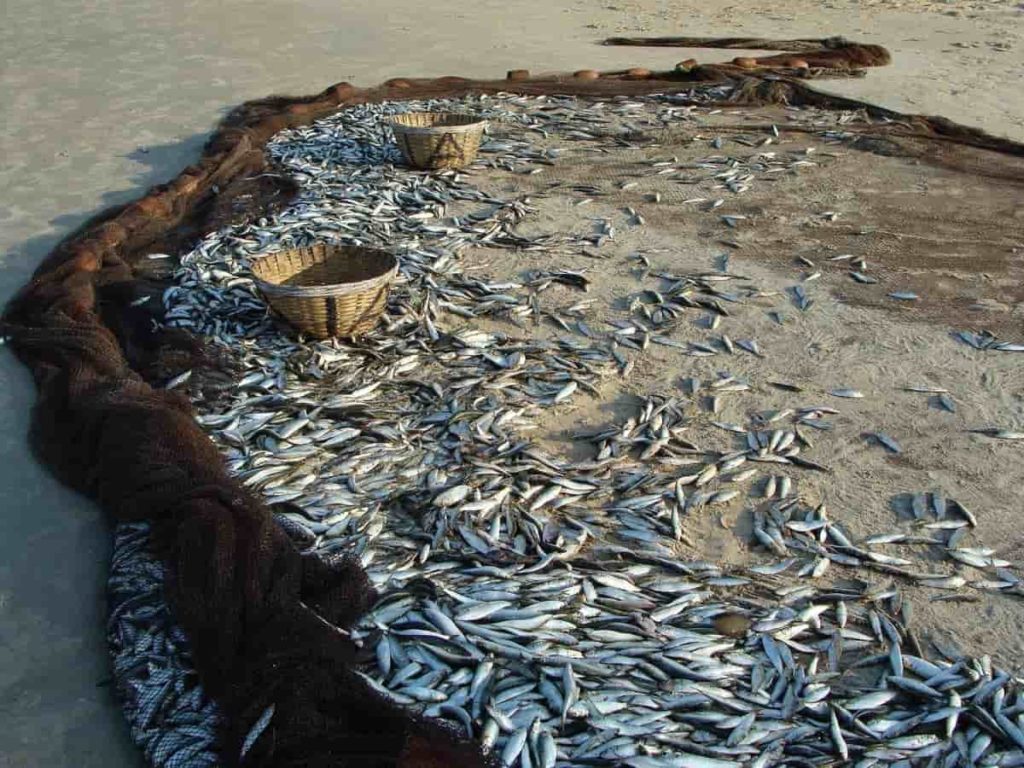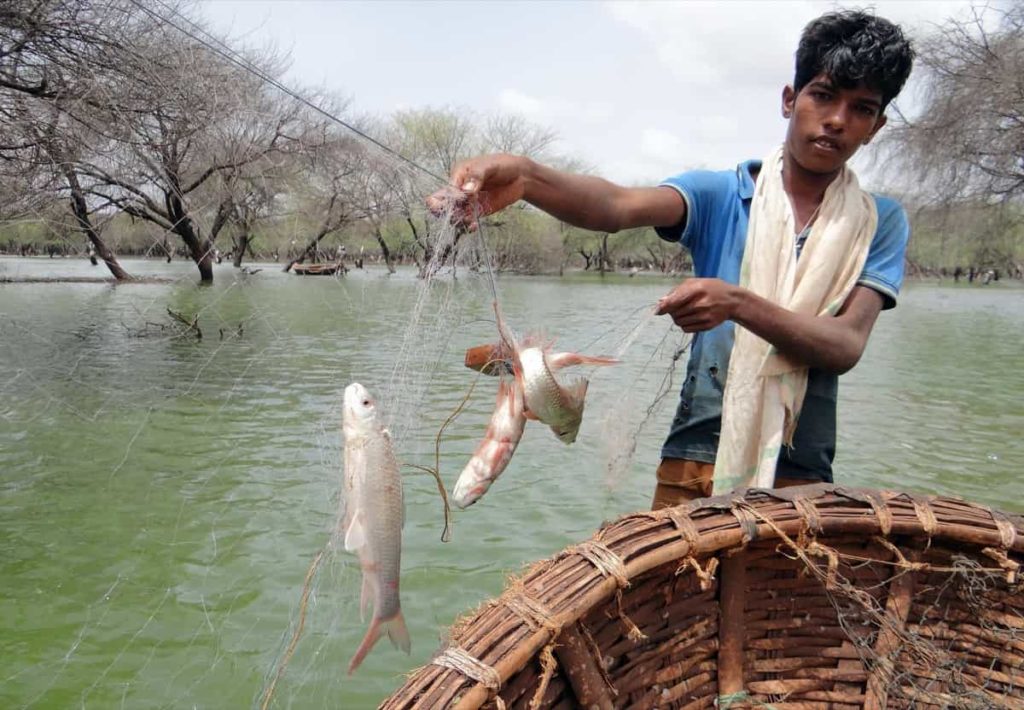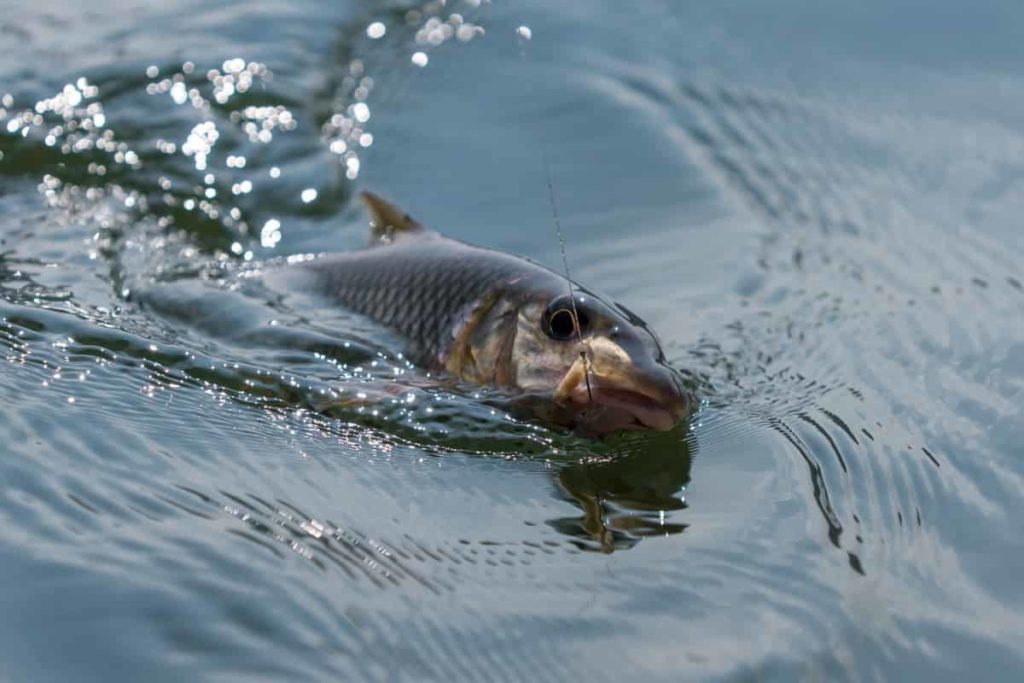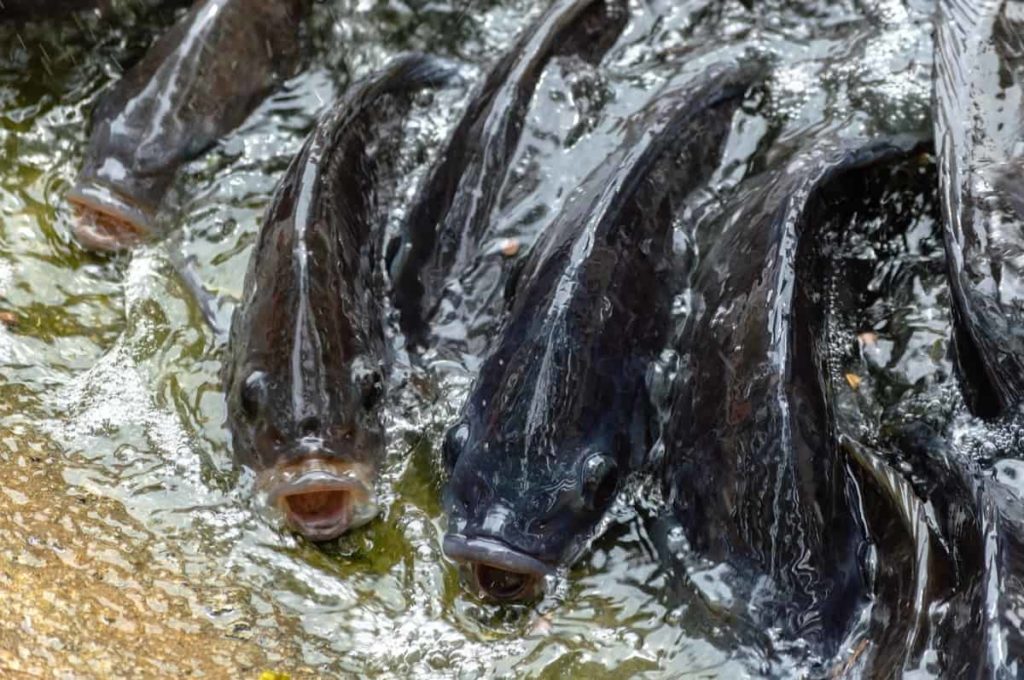Fish production has witnessed tremendous growth in India, and the aquaculture sector will play an important role in feeding the rising demand for protein. Proper water management and supplying nutritious food and required minerals will increase productivity.

Common Fish diseases, symptoms and treatment
What is the most common disease in fish?
Fungal infections are one of the most frequently occurring disorders for fish. These infections in fish can damage various body systems like the liver, kidney, and brain and generally occur when the fish is in a weakened state, either due to wounds or trauma. It can also happen if a fish is placed in poor living conditions, i.e., substandard water quality or an overstocked fish tank. Fungal spores naturally populate fish tanks, but sick fish can cause a dangerous increase. These infections exhibit a white cotton-wool-like formation on the skin, mouth, fins, or gills.
How can I tell what disease my fish has?
Many diseases can affect fish growth. Fish are at higher risk of disease when placed in water with poor quality and an overstocked fish tank. These issues need to be addressed and treatment to control further spreading. Every disease has a specific symptom, and some symptoms are listed below,
- Aeromonas, Pseudomonas – Tattered fins and tail, Skin sores, Swollen abdomen. Bulging eyes. Red fins, skin
- Flavobacterium disease – Spots on the skin and mouth.
- Carp Pox disease – Bumpy growths on skin and fins.
- Lymphocystis – White pimples on skin and fins.
- Water mold – Cotton-like hair on fish, eggs
- Costia, Chilodonella, Trichodina, Epistylus – Increased gill movements and Fins clamped to sides. Fish settle on the bottom surface of the tank.
- White spot disease – White speckles on the body and fins.
- Velvet disease – Golden speckles on skin.
- Gill Flukes & Skin Flukes– Inflamed gills. Excess mucus on skin. Fish will Scrape bodies against rocks.
- Hole in the head disease – Spots on top of the head, back.
What disease kills fish?
White spot disease can wipe out all the fish in the tank within days. White spot disease is a contagious parasitic disease of fish. It is caused by a parasite called Ichyophthirius Multifilis. This parasite infects the fish after moving from the bottom of the pond. The parasite attaches to the fish, moving under the skin where it feeds on cells and body fluids. Infected fishes exhibit symptoms like scratching against stones, and grass, Disordered swimming, and Fins folded against the body
What are the symptoms of Saprolegniasis?
Saprolegniasis is a disease affecting fish eggs and fishes and is caused by the pathogenic oomycete Saprolegnia parasitica. This disease is characterized by greyish-white patches on the body or fins of fish and is associated with tissue damage leading to death. The clinical signs of Saprolegniasis include haemorrhagic ulceration; erosion of skin, fins, gills, and muscles; systemic mycosis of the spleen, eyes, liver, and kidney, and massive mortality. Low water temperature is the first reason for the spread of this disease.
In case you missed it: Best Practices to Grow Tamarind Trees: Check How this Guide Helps Beginners

What causes fungal disease in fish?
The fungal infection in fishes is caused by having an unclean environment containing dead and decaying organic matter. Keeping a clean environment for fish is always a good practice to prevent diseases. The fish fungus appears as gray or white patches on the skin or gills. They may become brown or green later as they trap sediment.
Most common fungal diseases of fish
Saprolegniasis
Saprolegniasis is also called winter fungus. This disease is caused by fungi, usually in the genus Saprolegnia. This fungus mainly affects and is found in freshwater fish and fish eggs; saprolegniasis is a secondary infection typically seen when water temperatures drop below 15°C and then increase in the early spring. Focal grey-white patches are the signs of this infection. Respiratory distress will be evident if the gills are involved and lead to death rapidly.
Branchiomycosis
Branchiomycosis is also known as gill rot. This disease is caused by Branchiomyces sanquinis, an obligate pathogen, and is more common in fishes. Fish suffering from gill disease will have respiratory problems, Because the gills are primarily affected, with visibly rapid or difficulty breathing and swimming nearer to the surface of the water. They will show symptoms of a lost appetite.
Epizootic ulcerative syndrome (EUS)
Epizootic ulcerative syndrome is one of the most serious infections noticed in fish. Aphanomyces infection causes this infection. Epizootic ulcerative syndrome is also called red spot disease. It can be seen in freshwater and brackishwater fish. Cutaneous microbiota plays the main role in protecting against pathogens. The potential for infection by pathogenic bacteria increases by perturbing the integrity of the cutaneous microbiota. This disease is associated with mass mortality of susceptible fish in areas that are initially affected.
Ichthyophoniasis
Infection by the obligate fungal pathogen Ichthyophonus hoferi has been seen in freshwater fishes, but principally infection occurs in stocks in the marine environment. The most characteristic sign of Ichthyophonosis in herring and flounder was the formation of creamy white nodules on the heart.
This infection results in chronic systemic granulomatous inflammation. There is no treatment available for Ichthyophoniasis. Cultured fish become affected when fed raw trash fish contaminated with the pathogen. Therefore, contaminated trash fish should be carefully avoided to prevent transmission of this disease.
In case you missed it: Common Sheep Diseases, Symptoms, and Treatment: Check How this Guide Helps Sheep Farmers

What is Furunculosis in fish?
Furunculosis disease is generally seen in wild and cultured salmonids (trout and salmon). This disease is caused by the obligate bacterium called Aeromonas salmonicida. It causes bacterial septicemia and is often fatal in farmed fish if not treated promptly with antibiotics. Fish infected by this bacterium often exhibit lethargy, dark skin, and bleeding at the start of fins. Few external signs will be identified in acute disease, and heavy mortality can happen. The bacterium infects many freshwater and marine fishes as it has a wide host range.
What are the main diseases of fish?
Bacterial diseases are commonly seen in dense populations of cultured and aquarium fish. These diseases are frequently associated with poor water quality, organic loading of the aquatic environment, handling and transport of fish marked temperature changes, hypoxia, or other stressful conditions. Most bacterial pathogens of fish are aerobic, gram-negative rods.
Columnaris Disease
Columnaris, also called cottonmouth, is a symptom of disease in fish. This disease results from an infection caused by the Gram-negative, rod-shaped bacterium Flavobacterium columnare. It was also called Bacillus Columnaris, Chondrococcus Columnaris, Cytophaga Columnaris, and Flexibacter Columnaris.
Columnaris looks like a fungal disease, but it is a bacterial infection that causes illness and death in most kinds of fish. Tropical fish will get affected by this, as well as coldwater fish. Saltwater fish are less likely to get the disease, as salt is one of the many treatments for the infection.
Tail rot and Fin rot
Fin rot and Tail Rot are common diseases of freshwater and aquarium fish. This disease is caused by several gram-negative bacteria and often occurs along with other diseases. Fin and Tail Rot can be cured if the disease is identified early but difficult to cure, especially in the more advanced stages.
Bacterial gill disease or Gill rot or Environmental disease
Gill rot disease, also called Branchiomycosis, is caused by Branchiomyces sanguinis and Branchiomyces demigrans in fishes. It is a fungal infection involving gill tissues, affecting most freshwater fish. It is characterized by infarction necrosis areas of the gills, anorexia, and the marpling appearance of the gills. Bacterial gill disease is characterized by large numbers of filamentous bacteria on the gills, accompanied by clubbing and fusing of the gill filaments. Acute or chronic forms of the disease will occur and lead to death.
Aeromoniasis or Motile Aeromonas septicaemia
Aeromonas hydrophila is a Gram-negative, motile bacterium that causes motile Aeromonas septicemia disease in fish. This bacterium is widely spread in aquaculture and can result in significant economic losses. It generally occurs due to poor nutrition or sanitation and is recognized by the red ulcers which cover the fish. Koi and goldfish are the pet fish most susceptible to Aeromonas infections, as these are fresh, warm water fishes.
In case you missed it: Best Practices to Grow Taro Root at Home: Check How this Guide Helps Beginners

Edwardsiellosis or Edwardsiella septicaemia
Edwardsiellosis is one of the most common bacterial diseases in fish. Edwardsiella piscicida is abundant in water and causes food and waterborne infections in fish. The bacterium responsible for Edwardsiellosis in farm fish can lead to severe economic losses in aquaculture. Edwardsiella tarda commonly lives in the intestine of fish and other aquatic animals. The mortality of infected fish will be acute but is often chronic, depending upon the environmental conditions under which these infections occur.
Vibriosis
Vibriosis is the most common disease resulting in massive mortality of cultured fish. A high incidence of vibriosis can occur in the incubator and grow-out facilities, but juveniles are more susceptible to the disease. Various factors, particularly the source of fish, environmental factors like water quality and farm management, and the virulence factors of Vibrio, affect the occurrence of the disease. Affected fish show weariness, with necrosis of skin and appendages, leading to body malformation, slow growth, muscle opacity, and mortality.
Pseudomoniasis/Psedomonas septicaemia:
Pseudomonads are one of the most dangerous fish pathogens that induce chronic inflammation and ulcers in the large intestine. Various bacterias affect many fishes and are responsible for considerable economic losses. The economic losses are due to poor growth, high mortalities, and improper flesh quality. Pseudomonas aeruginosa is a part of stressful conditions such as malnutrition and overcrowding; the bacteria have become highly opportunistic and pathogenic, causing serious illnesses including gill necrosis, abdominal distension, friable liver, and congested kidney.
Enteric Red Mouth Disease:
Enteric redmouth disease (ERM) is most commonly seen in fish farms with poor water quality. The disease is identified by the mouth, fins, and eyes subcutaneous hemorrhaging. Enteric redmouth disease (ERM) is a serious bacterial disease of salmonid fish. It is caused by a Gram-negative rod-shaped enterobacterium called Yersinia ruckeri. It has a broad geographical distribution and causes significant economic losses in the fish aquaculture industry.
What is Motile Aeromonas Septicemia?
Motile Aeromonas Septicaemia (MAS) is the most commonly seen disease caused by Aeromonas hydrophila. It is a pathogen causing disease in fish under stress. The bacterium produces several pathogenic factors, and the most important among them is releasing the toxins that will affect blood cells, provoking the disease. Severe MAS displays a wide range of signs indicating variation in the progression of the disease. External signs in fish include reddened fins, inflammation of the anus, diffuse hemorrhages on the skin, exophthalmia, and abdominal swelling.
In case you missed it: Common Dairy Cattle Diseases, Symptoms, and Treatment: Check How this Guide Helps Dairy Farmers

How do you prevent vibriosis in fish?
Vibriosis is the most common disease leading to massive mortality of cultured fish and shellfish. A high incidence of vibriosis can occur in the incubator and grow-out facilities, but juveniles are more susceptible to the disease. A combination of control measures, particularly a disease-free source of fish, biosecurity measures of the farm, improved water quality, and other preventive measures like vaccination will control the infection.
How do you prevent Aeromonas hydrophila in fish?
Aeromonas hydrophila is a Gram-negative, motile bacterium that is the causative agent of motile Aeromonas septicemia in fish. The Aeromonas bacterial infection affects multiple systems in the fish body, resulting in symptoms like enlarged eyes, accumulation of fluids in the abdomen, renal dropsy, and ragged fins.
Depending on the severity of the Aeromonas bacteria in the fish, the veterinarian will suggest medication to eliminate the infection. Usually, antibiotics are used to treat this disease. This medication may be injected into the fish or added to the fish’s water.
What causes parasites in fish?
One of the most common problems of tropical and ornamental fishes is those caused by parasites. Parasitic diseases of fish pose a significant threat to fish populations. Parasitic infections in fish are diagnosed by direct observation, wet mount preparations of skin, gill, fins, fecal samples, tissue squashes, and blood smears.
Ichthyophthiriasis (Ich/White spot disease)
This disease is a major problem for freshwater and commercial fish. All freshwater fish species are susceptible, and the parasite has also been found in cultured and wild fish. Ichthyophthirius multifiliis is a large protozoan that causes this disease. It is also called white spot disease. These large parasites cause the white spots on the skin and fins of affected fish. The disease is highly contagious and transmits rapidly from one fish to another. It is considered a warm water disease that occurs when water temperatures change, especially in the spring.
Trichodiniasis
Trichodiniasis is one of the major diseases seen in aquaculture. It affects the production of several fish species and has harmful effects, particularly on production. Trichodinads reproduce by binary fission under usually optimal conditions for the host fish. Most species are host specific and spread from affected fish to healthy fish by incidental contact and contact with the organism in the water column.
Dactylogyrusis (Gill fluke):
Flukes that infect freshwater fish are called monogenean flukes, and Gill flukes are a type of flatworm that affects fish. This parasitic flatworm’s scientific name is Monopisthocotylea. These worms stick to the skin, gill cavities, and mouthparts of many types of fish, including catfish, goldfish, and cichlids.
Dactylogyrus infections are widely spread during late autumn or early winter. These flukes are egg producers that lay eggs in the fish intestine. Then, the larva will hatch and go through a free-swimming stage before sticking to the gills. The time taken for converting larva into monogenean fluke infestations will be very short, as one day.
Gyrodactylosis(Skin fluke):
Gyrodactylus Salaris is also known as salmon flukes. These tiny monogenean ectoparasites live on the Fish skin and can infect many types of fish and frogs.
What are the symptoms of Gyrodactylus?
Like a good hand lens, the parasite can be easily seen under low power magnification. Without magnification, heavily infected parr appear greyish, with excess mucus and concurrent fungal infections. These parasites attach to the host by the attachment organ, or opisthaptor, at one end of the body and feed using glands at the other. These parasites can cause large wounds, and feeding can damage the epidermis, allowing secondary infection.
The affected fishes may exhibit signs including may become mottled, necrotic, and dark with excess mucus production. Infestation of the gills often results in hyperplasia, accompanied by rapid respiratory movements. Heavy body infestations cause fin erosion with flashing behavior.
What causes cotton wool disease in fish?
The cotton wool disease is caused by the bacteria Flavobacterium Columnare. Despite its fungus-like appearance, it is not a fungus. It infects the skin and gills and is important to the commercial aquaculture market. Columnaris bacteria are usually found on the skin, mucus membranes, gills, and inside healthy fish. In small, controlled numbers, they are harmless organisms. But, they tend to explode in population if the conditions favor them. The Columnaris bacteria become a cotton wool disease, transforming into a dangerous and fatal contagious infection.
In case you missed it: Common Poultry/Chicken Diseases, Symptoms, and Treatment: Check How this Guide Helps Poultry Farmers

What are the symptoms of Trichodina?
Affected fishes show some clinical signs like sluggish movement, necrosis and ulcer on different body parts, loss of appetite, black coloration, detached scales, and excessive accumulation of mucous in gill pouches.
How do you treat Columnaris disease in fish?
Columnare causes acute to chronic infections in fishes. It affects the gills, the skin, and the fins. The clinical manifestation of Columnaris disease is dependent on the virulence of the eliciting strain. This infection has slow progressive infections at water temperatures above 21°C and causes massive tissue damage before death occurs.
External infections will be treated with antibiotics, chemicals in the water, or both. Management plays a key role in the prevention of the disease. Lower rearing density can also decrease the spreading of these parasites and could be an efficient tool in ecological disease management.
How do you confirm if your fish has a bacterial infection?
Most bacterial infections are occurred by Gram-negative organisms, including the genera Aeromonas, Pseudomonas, Citrobacter, Edwardsiella, Flavobacterium, and Vibrio. Aeromonas is more commonly a pathogen in freshwater fish, while Vibrio usually infects marine fish. Conditionally pathogenic microorganisms cause bacterial fish diseases.
One of them is Acinetobacter, widely distributed in nature and aquatic environments. Bacterial infections transmit in many ways, but common signs include a white film on the fish’s body or fins, cloudy eyes, tattered fins, and hemorrhaging or open sores on the body and mouth.
Conclusion
The diseases caused by fungi and bacteria are prevented by strict biosecurity measures, maintaining water quality, and rearing less dense fishes.
- Crops Grown in Summer Season: Best Choices for Summer Gardening
- Organic Pest Control for Tomato Farming
- How to Maximize Sheep Farming Profit
- Broccoli Varieties: Choosing the Right Cultivars for Your Farm
- How to Raise Pigs in Your Own Backyard: A Comprehensive Guide
- Budget Friendly Sheep Shed Ideas: Cheap and Low-Cost Tips
- How Much Do Cattle Farmers Make: Revenue Streams in Cattle Farming
- Management Pests and Diseases in Your Cotton Field
- Sheep Farming Business Plan for Beginners
- Aquaponic Farming at Home: A Step-By-Step Guide
- Profitable Village Farming Business Ideas in 2024
- High-Yield Aquaculture: Fast-Growing Fish for Farming
- Effective Fish Pond Construction Techniques for Beginners
- Irrigation and Water Management in Pineapple Farming
- Blossom to Harvest: Mastering Flowering and Pollination in Papaya Farming
- Pig Fattening Essentials: From Selection to Sale for Beginners
- Raising Wagyu Cattle: A Complete Guide for Premium Beef Production
- Soil Types and Their Water Holding Capacity
- Optimizing Irrigation Schedules for Coconut Groves for Enhanced Yield
- Espresso Your Garden: Coffee Grounds for Healthier Acid-Loving Plants
- The Best Soil Mix for Snake Plants: How to Mix Your Own Snake Plant Soil
- Green Thumb Success: Expert Tips for Cultivating Greenhouse Beans All Year Round
- Bloom All Year Round: The Ultimate Guide to Indoor Hyacinth Care
- Eco-Friendly Gardening: How to Make Liquid Fertilizer from Kitchen Waste
- Ultimate Guide to Grow Anise in Pots: Explore Seed Propagation to Harvesting
- Guide to Raising Chester White Pigs: Discover Breed Facts to Growth Management
- Mastering the Elegance: The Ultimate Guide to Weeping Cherry Tree Care, Planting, and Maintenance
- Ultimate Guide to Planting Garlic in Grow Bags: Growing Strategies for Beginners
- How to Fix Spider Plant Leaf-Related Problems: Natural and Organic Remedies
- 10 Reasons Why Your Tulsi Plant is Shedding Leaves: Home Remedies and Solutions
- Optimizing Growth and Yield: The Advantages of Palm Bunch Ash Fertilizer
- Utilizing Neem Oil Extract as a Natural Pesticide for Hydrangea
- From Soil to Harvest: Various Ways in Which Farmers Can Use AI Tools
- Steps to Encourage and Induce Citrus Flowers: A Comprehensive Guide
- How to Fix Snake Plant Leaf-Related Issues: Natural and Organic Remedies
- Transform Your Garden into a Fragrant Oasis with Raat Ki Rani (Night Blooming Jasmine)
